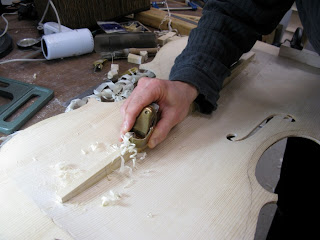Then we can start the making of the bass bar that has both a role of strengthening the front under the bridge bass foot and carrying the sound a bit more across the sound board (the front).
The wood used for it is narrow grain spruce and it is fitted perfectly to come to a specific place inside the soundboard.
It is also fitted slightly offset to the front wood grain as to not create any weakness (therefore cracks) at the seam with the front.
 Once glued, the bass bar is given a streamline shape. (This picture shows it just glued and unshaped)
Once glued, the bass bar is given a streamline shape. (This picture shows it just glued and unshaped)I like gluing my bass bar with restaurer's clamps rather than bass bar pegs as their pressure is from the top and guaranty less distortion and flaws - so does Douglas.
 In the process of shaping the bass bar, we dispose of the wood on it that is unnecessary extra weight and doesn't act as support.
In the process of shaping the bass bar, we dispose of the wood on it that is unnecessary extra weight and doesn't act as support.


Aucun commentaire:
Enregistrer un commentaire